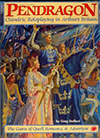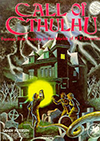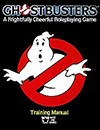100 Best Games - Pendragon
Just click on the game cover to read the related essay

Pendragon - Shannon Appelcline
Key Designer: Greg Stafford
Chaosium (first edition, 1985)
In the mid-1980s two divergent design philosophies appeared in the roleplaying industry. On the one hand you had universal systems meant to apply to all possible genres. GURPS (1986) is the best-known example of this type of game. On the other hand you had systems that were increasingly specialized for precise settings. King Arthur Pendragon (1985), by Greg Stafford, is not only one of the finest examples of the latter sort of game, but is often held up by designers to show how powerful creating a game for an individual setting can be.
The background of Pendragon is, of course, the tale of Arthur and his Round Table, particularly as described in Sir Thomas Malory’s Le Morte D’Arthur. Pendragon’s game system is a distant cousin to Chaosium’s Basic Role-Playing that offers simpler gameplay. Characters are defined by statistics and skills, and the skills can be individually increased through usage.
Part of the beauty of Pendragon lies in the fact that the whole game is designed to simulate Arthurian stories. Players play knights — not thieves, men-at-arms, clerics, or magicians (except in the out-of-print fourth edition, which did introduce Celtic magic). They duel in tournaments, feast in great halls, and quest for the glory of their lord. This knightly milieu is further highlighted by an innovative system of “personality traits” and “passions.”
Legendary Arthurian Britain was a place of strong emotions. Christianity and Paganism clashed, just as Rome sought to chain the independent British spirit. Each of these cultures had different moral ideals, and it is those ideals that come to the forefront in Pendragon’s personality traits. To use the game’s terms, a pagan is energetic, generous, honest, lustful, and proud, while a Roman Christian is chaste, forgiving, merciful, modest, and temperate.
Each of these traits is embodied through an opposing pair of mental characteristics such as just/arbitrary and modest/proud. A character starts out with values in each pair of traits that add up to 20. These values will then change during play: when a knight acts in a way appropriate to a trait — by, say, demanding a defeated foe be treated justly by the local lord — the game master awards increases to that trait (just), and the opposed trait (arbitrary) decreases, as well.
Through continued change a character can eventually qualify for magical rewards appropriate to his culture and religion, such as improved constitution or mystical armor. These rewards encourage players to act in knightly ways appropriate to the setting, while at the same time setting up the pivotal cultural conflicts that defined Arthurian Britain.
Pendragon’s passions are similar to personality traits, but they reflect the more tragic and uncontrollable emotions depicted in Malory’s Le Morte D’Arthur. Just as Lancelot slept with his king’s wife, and later slew Sir Gareth and many other knights to save her from burning, so the players might also be possessed by destructive and irrational fervors. Pendragon’s passions include fears, loyalties, loves, and hatreds. They help make the player knights into fully realized characters who sometimes act tragically — just like King Arthur, Sir Lancelot, Queen Guinevere, and the rest of the Round Table.
Together these personality traits and passions add a new, moral dimension to Pendragon, one that appeals to parents, educators, and others concerned with the content of roleplaying games. Characters are required to face difficult ethical and emotional challenges, but always have guides at hand. The “Twelve Rules of the Round Table,” featured in the supplement Book of Knights (2000), includes such dictates as “to injure no one needlessly” and “to practice religion most diligently.”
Another way in which Pendragon reflects the thematic content of Le Morte D’Arthur is through the genealogical and generational components of its character design rules. Malory’s story is very much about families. Uther Pendragon becomes king of Britain to avenge his brother, Aurelius Ambrosius. The feud between Lot of Orkney and Pellinore of Listenoise, and their families, motivates the actions of several important figures throughout the tale, and contributes to Camelot’s doom.
During character creation, a Pendragon player learns not just about his character’s immediate past, but also about the adventures had by his father and grandfather. This emphasizes the character’s place within a larger web of relationships. Then, after each adventure, characters are assumed to “winter,” and a year passes. Over months of play, this mechanic ages characters rapidly. And when a knight character becomes too old to adventure, a player creates his successor, an heir who shares some of his sire’s characteristics, but is unique in other ways.
Each character’s family tree grows from the fertile soil of Arthurian legend. The core Pendragon rulebook outlines the Matter of Britain in broad strokes, from the reign of King Uther to the death of Arthur at the disastrous battle of Camlann. The Matter is handled in much greater detail in The Great Pendragon Campaign (2006), an impressive 429-page tome that describes the whole story, chronicling every year from 485 to 566, with lists of court events and battles for each summer. It also includes about 100 short adventures scattered across this history. Still, game masters are not required to tie their own campaigns to any specific events; it’s up to each gaming group to determine where and how its shared story intertwines with the complicated tale of Camelot’s rise and fall.
Many roleplaying games have attempted to construct a compelling metaplot, a controlling storyline that defines the direction of the entire game line. However, such storylines very often suffer from the lack of a unified vision. Not so with Pendragon. From the start, the game has developed against a clear and consistent narrative, one with a beginning, middle, and end well known to its players. How they interact with that familiar story and strive, through their characters, to face the moral challenges it depicts and embody the noble ideals it promotes — that is the heart of the Pendragon gaming experience.
King Arthur Pendragon could be lauded as a top RPG solely based upon the innovation it brought to the industry. Its concentration on epic storytelling and its traits mechanic were both notable and original when the game was released in 1985. However, even today, Pendragon remains vital. It provides a picture-perfect model of literary knighthood and, through its well-crafted and well-considered design, effortlessly conjures its theme — so successfully, in fact, that few other publishers in the last 20 years have even tried to bring another Arthurian roleplaying game to market. You just can’t improve on perfection.
King Arthur Pendragon has had many homes in recent times, including Green Knight, White Wolf, and Nocturnal Media, but as of 2018, it's back where it belongs, with Chaosium. The fifth edition rules and the The Great Pendragon Campaign remain the strong core of the line, but Chaosium also offers a robust library of classic supplements, as well as related games of knightly honor such as Paladin and Prince Valiant.
Shannon Appelcline writes about roleplaying history and board game design. His award-winning five-book series on the history of roleplaying companies, Designers & Dragons, has been published in both English and German. His analysis of cooperative board game design, Meeples Together, was recently released by Gameplaywright Press. Shannon is also a technical writer, specializing in blockchains and digital identity.
Essay © copyright 2007, 2019 Shannon Appelcline. Originally published, in unrevised form, in Hobby Games: The 100 Best, edited by James Lowder, Green Ronin, 2007. Reprinted by permission of the author.





